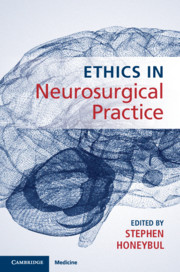Book contents
- Ethics in Neurosurgical Practice
- Ethics in Neurosurgical Practice
- Copyright page
- Contents
- Contributors
- Introduction
- Part I General Ethics
- Part II Neurosurgery-Specific Bioethics
- Part III Future Developments
- Chapter 20 Ethical Aspects of Innovation in Neurosurgery
- Chapter 21 Stem Cells and Brain Repair: Ethical Considerations
- Chapter 22 Brain-Machine Interface Technology in Neurosurgery
- Chapter 23 International Neurosurgery
- Chapter 24 Live Televised Surgery
- Index
- References
Chapter 21 - Stem Cells and Brain Repair: Ethical Considerations
from Part III - Future Developments
Published online by Cambridge University Press: 29 May 2020
- Ethics in Neurosurgical Practice
- Ethics in Neurosurgical Practice
- Copyright page
- Contents
- Contributors
- Introduction
- Part I General Ethics
- Part II Neurosurgery-Specific Bioethics
- Part III Future Developments
- Chapter 20 Ethical Aspects of Innovation in Neurosurgery
- Chapter 21 Stem Cells and Brain Repair: Ethical Considerations
- Chapter 22 Brain-Machine Interface Technology in Neurosurgery
- Chapter 23 International Neurosurgery
- Chapter 24 Live Televised Surgery
- Index
- References
Summary
The rapid advance of research in stem cells has opened the door for their potential use in cell-based therapies to treat neurological conditions some of them incurable to date. Encouraging studies in animal models are moving into early phase clinical trials that hold realistic promise for the future. However, important ethical challenges remain as stem cells are translated from preclinical research to the clinical realm.Translation of stem cell–based therapies must be framed within a rigorous scientific and ethical process. This framework extends to the continuum of basic science in the laboratory, subsequent animal studies to the execution of early and late phase clinical trials in humans.Neurosurgery will play a fundamental role in the stem cell therapies of the future. New neurosurgical techniques and instruments will be developed for the delivery of stem cells to single or multiple targets within the CNS. Neurosurgeon’s roles will expand as stem cells move from clinical trials to effective potential therapies. This chapter will review selected stem cell ethical issues, that may inform and guide the practicing neurosurgeon in a rapidly moving field of great scientific promise, as well as ethical challenges
Keywords
- Type
- Chapter
- Information
- Ethics in Neurosurgical Practice , pp. 214 - 223Publisher: Cambridge University PressPrint publication year: 2020



